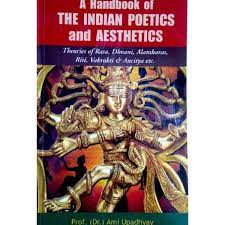
Here is my blog on Indian Poetics in our Paper no.9 Literary theory & Criticism and Indian Aesthetic we have Indian Poetics as a unit to study here is a look at what is Indian Poetics.
The Sanskrit word for literature is SAHITYA, which etymologically means coordination, balance, concord, and contact. In the Indian Poetics definition of literature is defined as kavya as Aristotle defines “Poetics”. It enhances beauty and worth but there is a spine line difference between Indian Poetics and Western Poetics.
Indian Poetics is Based on ...

Bharata Muni is the one who first gave Indian Mimansa. According to him, language and voice are very different and just because of this it is impossible to settle everything in language as language is immortal while emotions/Bhavas are mortal. Rasa is the spine of the poetry. Rasa theory is superior among all theories.
T. N. Shreekantaiyya says that “The principle of Rasa is the very central part of Indian poetics. It is the nectar that founders or thinkers have obtained after churning the ocean of poetry.”
What is RASA?
“A blending of various Bhavas arise certain emotion, accomplice by the thrill and a sense of joy is Rasa.” In the sixth chapter of Natyashashtra, he explains NATYARASA and RASA as the soul of poetry. विभावानुभावव्याभिचारी संयोगात रसनिष्पत्ति ।
He has mentioned nine Rasas in Natysastra with their color and god.
श्रृंगार-वीर-करुणाद्भुत-हास्य-भयानका: ।
बीभत्सरौद्रौ शान्तश्च रसा: नव प्रकीर्तिता: ।।
Sentiments | Bhavas |
Erotic | Attractiveness |
Comic | Mirth |
Furious | Furg |
Pathetic | Tragedy |
Odious | Aversion |
Heroic | Heroic Mood |
Bhayanaka | Horror |
Adbhutam | Wonder |
Shantam | Peace |
Worthy to note that RASA comes out only because of these four BHAVAS Vibhav, Anubhav, Sancharibhav, Sthayibhav, and Sthayibhav. Natysastra is the foundation of fine arts in India.
2) Alamkar Theory
Bhamaha is the first who introduced alamkara poetics. The second and third chapter of KAVYALLAMKARA deals with 35 figures of speech.
Mammata enumerates sixty-one figures and groups them into seven types like…
Mammata enumerates sixty-one figures and groups them into seven types like…
1. Upma= simile
2. Rupaka= Metaphor
3. Aprastuta Prasmsa =Indirect description
4.Dipaka= Stringed figures
5.Vyatreka =Dissimilitude
6.Virodha =Contradiction
7.Samuccaya= Concatenation
3) Riti Theory
Riti is the way of presentation or the style of presentation. He is one who developed it into a theory of “Vishista Padrracana”. Riti is a formation of arrangement of marked inflected constructions. Vamana’s scheme of the Gunas can be tabulated thus
1. Shabda Duna = Ojas or compactness of Word structure
2. Artha Guna = Ojas or Maturity of Conception
* Four types of Writing style
1. Vaidarbhi
2. Panchali
3. Gaudi
4. Lati
4) Dhvani Theory
Dhvani means The suggestive quality of poetic language. Other regards to this sense of poetry next school of thinkers, known as DVANI headed by Anandbardhan. He points out that it is not the literal, simple or direct, and referential meaning that poetry properly expresses, but it suggests indirect and emotive meaning. Hence, the words of a poem must be given their due importance and the same with regard to the literal sense they denote, yet both the words and their direct meaning to express themselves. The theory proposed in Dhvnyaloka by Anabdvardhana is known as the name of “Dhvani”. ‘Dhvnyaloka’ is itself a huge compendium of poetry and poetics.
5) Vakrokti Theory
Karnataka is known as the originator of this Sanskrit literary theory. Vakrokti is a theory of poetry that perceives poetry essentially in terms of the language of its expressions. Here Vakrokti turns into beauty.
Kuntakawas is a Sanskrit poetician and literary theorist who is remembered for his work Vakroktijivitam in which he postulates the Vakrokti Siddhānta or theory of Oblique Expression, which he considers as the hallmark of all creative literature.
This image is showing types of Vakrokti and each type consists of its own value in the poem.
6) Auchitya Theory
Kshemendra’s discussions of the principle of Aucitya are from the point of view of both the writer and the reader and are articulated in its given cultural and philosophical context. Kshemendra made aucitya spine elements of literariness. He defines aucitya as the property of an expression being an exact and appropriate analog of the expressed.




No comments:
Post a Comment